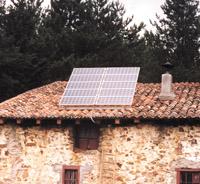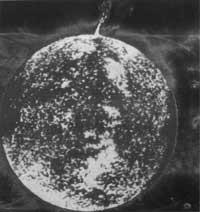Solar panels
1999/05/01 Imaz Amiano, Eneko - Elhuyar Zientziaren Komunikazioa Iturria: Elhuyar aldizkaria
half of its life. It is therefore a guaranteed energy source for the next 6 billion years.
The surface of the Earth does not reach more than a part of the energy produced by the sun, but as renewable energy, solar energy has some characteristics that make it very interesting for its use: on the one hand, it is an inexhaustible source of free energy and, on the other, it has a great energy quality, since the concentration of solar radiation allows to reach temperatures of up to 3,000 °C, and finally, the pollution system does not present a slow environmental advantage.

However, solar energy presents defects or obstacles that become major problems: It does not reach Earth continuously, but undergoes night, day and seasonal cycles, as well as variable atmospheric conditions (clouds, mists, etc. ). On the other hand, before use and/or storage, it is necessary to perform a transformation to another type of energy (thermal, electric). In this sense, the transformation and accumulation of electrical energy requires batteries that, being lead/acid, gel or nickel/cadmium, are pollutants. Third, although solar energy is free, the technology for its use is very expensive. However, the lack of such energy is relative. Compared to the current prices of traditional energy sources, it is expensive, but the actual price of the latter would be much higher if its environmental costs were taken into account (nuclear waste processing, greenhouse effect and acid rain, for example).
Finally, although the production of photovoltaic energy is a very clean process, the products used in the manufacture of cells are toxic and their transformation into waste after exhausting the life of photovoltaic cells (in about 30 years) can cause problems if not managed properly. However, it should be noted that most of the toxic materials in cells are recyclable. On the other hand, the use of large surfaces in the case of large power plants has also been of concern, although compared to the space occupied by the electric power unit produced by traditional power plants it can be said that they need a similar surface.
As for the performance of the energy conversion, this is very low (around 20%), so to think that in the short term much solar energy will be used is optimistic. It is estimated that 10% of the total energy consumed in developed countries within a few decades will be solar. On the other hand, in developing countries with strong winds, there are few who claim that this percentage will be much higher.
Uses of solar energy
There are two ways to use solar energy directly and actively. On the one hand, it can be used to heat a fluid using suitable collectors. On the other hand, photovoltaic cells allow to directly transform solar energy into electric energy. Both processes have nothing to do with both technology and application.
Thermal use of solar energy
This heating system is not exclusive to hot areas and, for example, in Canada, the solar water heating industry has become in recent years a highly competitive industry. There are also exemplary facilities in the Basque Country.
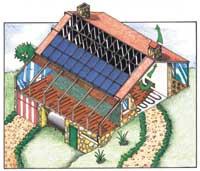
The solar hot water system could be installed in any home (see Figure 1) and get 75% of the hot water from this source. It can also be used in sports, swimming pools and industry, as well as building heating systems. Low temperature systems are used in homes, sports centres and swimming pools. In industrial processes, the most common systems are those that reach a temperature between 80ºC and 250ºC. The principle of operation is very simple: thermal plates capture the energy of the Sun and the water circulating through the tubes under the plate is heated. As already mentioned, hot water is sometimes obtained for use and in others the low-evaporation point liquid becomes gas to produce electric energy (see figure 2). In the application of steam electricity production, the temperatures to be reached are higher.
Interestingly, another field of application of solar heat is cooling. To get the cold, you need a heat source, which is what the solar panels placed on the roof offer. Arab countries are, among others, some of those who have begun to use this system effectively.
Photovoltaic energy
The system of electric energy production from solar radiation is based on the capacity of photovoltaic cells to transform the energy of solar rays into electric current. The basic production unit is the photovoltaic cell, formed by layers of semiconductor material that supply and capture electrons (see Figure 3).
The set of photovoltaic cells forms the solar panel. This is also called module and is the basic unit that is installed to produce energy. They can be joined as many times as you want.
The semiconductor that forms the photovoltaic cell is usually silicon, although other materials are currently used. Due to solar rays, some of the conductors' electrons are ejected from the crystalline structure. You don't have to let them go back, but in order for them to return to the positively charged holes in the region that have left empty, you have to create an external road, for example, with a metallic thread that links both regions. Electrons will move along the thread generating electrical current.
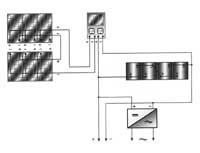
Monocrystalline silicon is the most widely used semiconductor today, as it is the most efficient (yield around 23%), but has a high production cost. Therefore, researchers have had to look for new ways. On the one hand, polycrystalline silicon is found, cheaper but of lower yield (15-17%). Amorphous silicon thin layers (0.001-0.002 mm) are the third option, economical but of lower yield (12% in laboratory). Fine sheets of other materials such as copper/indian/dyselenium “sandwiches” (CuInSe), titanium dioxide (TiO) and cadmium teluro have also been researched and developed, among others. Thin layers of cheap electrochemical techniques could be obtained (by baths). The recently developed titanium dioxide layers are of great interest for their transparency and can therefore be used as windows.
Until the oil crisis, the photovoltaic energy that began to develop in the 1950s was mainly used in satellites. Currently, in addition to satellites, it is available in three main areas: a) in small consumer products such as calculators, clocks; b) for those living far from the power grid and c) for the supply of the power grid.
In Navarre, unlike the particular properties and in terms of photovoltaic energy, the installed power is currently 96 kW, the largest in Gerinda with 320 panels, while in the thermal the installed surface is 6,000 m2. In the Autonomous Community of the Basque Country, however, in terms of photovoltaic energy, about 59 kW has been installed and in terms of thermal energy, about 580 m2.
Where can we use solar energy?
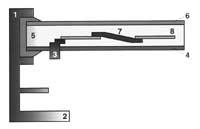
Today the use of solar energy by individuals is quite difficult, since existing buildings are not designed for it. However, there are things that can be done, especially in works of reform or new constructions. For example, in general installations in multi-storey street buildings, electric power can be obtained through solar energy, but probably forces should be directed to energy savings through design and insulation materials. However, more things can be done in unique homes. The construction of a new house of this type would be around 15% more expensive than that of a "normal" when it is built (12 million will cost 13 million), since the main increase in spending is due to a greater number of elements of isolation. Then, depending on consumption, we will need more or less time to amortize that difference.
In any case, it must be taken into account that for an autonomous installation of this type to be economically profitable (taking into account market prices and leaving aside environmental criteria, since they are not included in the prices), so that a home or other type of installation can access light energy must be at a minimum distance of 1.5 km. from the nearest point. In addition, where possible, an auxiliary system should be put in place when solar irradiation is insufficient or when demand is too high. All this without taking into account the environmental benefit.
Towards bioclimatic buildingsFirst, the appropriate orientation should be chosen and the south facing roof will be greater than the north facing roof for the installation of collectors and panels for thermal and photovoltaic use. On the south wall large stained glass windows can be placed so that the sun continues to cause the greenhouse effect and therefore the house is warmer. This will also allow the massive entrance of light. The roof collectors will be used to heat the water and the photovoltaic panels will give us the necessary electricity. The floor will be radiant, so hot water will circulate through the ducts installed in it. On the other hand, in order for the loss of heat and ventilation to be adequate, a series of measures will be taken into account: all the walls will be double partitions and the crystals will be double; in the north wall will be installed a glass greenhouse or a storage room that prevents the change outside the house is so abrupt (will allow us to save up to 25% energy in winter); in addition, all windows will have blinds to better control the interior environment. Finally, a small computer would allow us to control both the generation and consumption of electrical and thermal energy as well as the environmental conditions of the home, controlling the start-up or shutdown of pumps, opening or closing of blinds, on or off of lighting systems, etc. |

Gai honi buruzko eduki gehiago
Elhuyarrek garatutako teknologia




